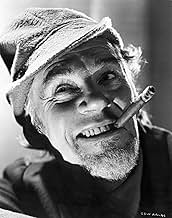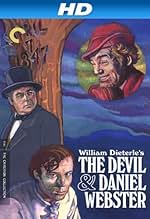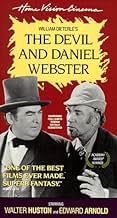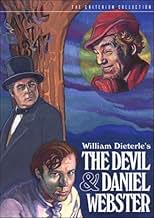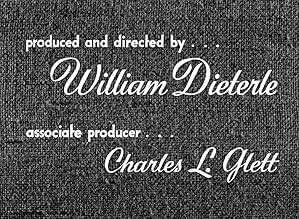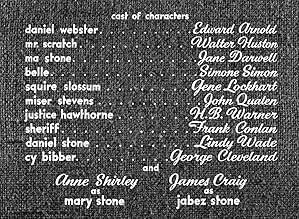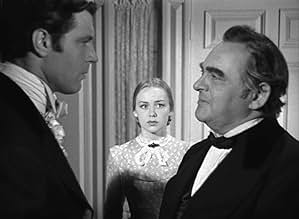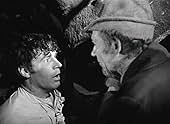A struggling farmer in 1840 New Hampshire makes a pact with Satan for economic success, then enlists famed orator Daniel Webster to extract him from the consequences of his contract.A struggling farmer in 1840 New Hampshire makes a pact with Satan for economic success, then enlists famed orator Daniel Webster to extract him from the consequences of his contract.A struggling farmer in 1840 New Hampshire makes a pact with Satan for economic success, then enlists famed orator Daniel Webster to extract him from the consequences of his contract.
- Won 1 Oscar
- 2 wins & 1 nomination total
- Spectator
- (uncredited)
- Hank
- (uncredited)
- Poker Player
- (uncredited)
- Woman
- (uncredited)
- Martin Van Buren Aldrich
- (uncredited)
Storyline
Did you know
- TriviaWilliam Dieterle had a habit of directing with white gloves on. Robert Wise said that everyone thought it was because he had a germ or dirt phobia. During shooting of one scene, Dieterle noticed there wasn't enough mud on a carriage wheel. He pulled off his gloves, grabbed some mud, rubbed it onto the wheel, then wiped his hands on his pants and put the gloves back on to continue directing.
- GoofsShortly after filming had begun, Thomas Mitchell fractured his skull and was replaced by Edward Arnold. Not many scenes had been shot, none were reshot, so Mitchell is still visible in some scenes. [Note: entries in the Trivia section indicate that all of Mitchell's scenes were reshot.]
- Quotes
Mr. Scratch: You shall have your trial, Mr. Webster. But I'm sure you'll agree, this is hardly the case for an ordinary jury.
Daniel Webster: Let it be the quick or the dead, so long as it is an American judge and an American jury!
Mr. Scratch: 'The quick or the dead!' You have said it.
[he stomps on the barn floor; a door opens]
Mr. Scratch: You must pardon the leathery toughness of one or two.
Jabez Stone: [afraid] Mr. Webster!
[a line of ghosts begin entering from the trapdoor]
Mr. Scratch: Captain Kidd - he killed men for gold. Simon Girty, the renegade - he burned men for gold. Governor Dale - he broke men on the wheel. Asa, the Black Monk - he choked them to death. Floyd Ireson and Stede Bonnet, the fiendish butchers. Walter Butler, King of the Massacre. Big and Little Harp, robbers and murderers. Teach, the Cutthroat. Morton, the vicious lawyer... and General Benedict Arnold. You remember him, no doubt.
Daniel Webster: A jury of the damned...
Mr. Scratch: [laughs] Dastards, liars, traitors, knaves. Your suggestion, Mr. Webster - 'the quick or the dead.'
Daniel Webster: This is outrageous, I asked for a fair trial...
Mr. Scratch: Americans, all.
- Crazy creditsFor some prints released under the title "The Devil and Daniel Webster", the opening credits start with the phrase "in front of the camera..." followed by a list of names only of the primary cast (no character names) and then the phrase "in back of the camera..." followed by a list of names only of the primary production crew, without their job roles, ending with the phase "all collaborated on the picture...." Then the title card is shown, with a story credit to Stephen Vincent Benet, and the note "this picture was originally shown with the title 'all that money can buy'." The title card is all in lower case. Finally, the opening prologue is shown as noted in another crazy credit item.
- Alternate versionsOver the years, this film was re-released more than once, partly because of its poor box office, and gradually cut down to 85 minutes. It remained in this form for many years, until it was recently restored to its full length. When this was done in the 1990s, it was unfortunately all too easy to tell which sections are restored... all the footage from the 85 minute version was in absolutely pristine, mint condition, while the long-lost, formerly missing footage has less than perfect sound and picture quality. However, the quality has been considerably improved on the DVD and on recent TV showings.
- SoundtracksCome, Ye Thankful People, Come
(uncredited)
Music by George J. Elvey
Lyrics by Henry Alford
A cautionary tale of greed and power, the narrative centers around the character of Jabez Stone (played by James Craig), a down-on-his-luck farmer who is barely able to support his family in 1840s New Hampshire. When the nefarious Mr. Scratch (Walter Houston) appears during a moment of weakness, Jabez agrees to sell his soul in exchange for seven years of good luck. Much to the dismay of his wife (Ann Shirley), mother (Jane Darwell), and beloved politician Daniel Webster (Edward Arnold), Jabez slips into a downward spiral as a result of his newfound wealth and power. When his seven years are up, Jabez learns the error of his ways and wants to make amends. To escape his contract with the devil, Jabez puts his fate in the hands of the almost mythic Daniel Webster, who represents him in a climactic barn room trial against Mr. Scratch and a jury of the damned.
The execution of this story is remarkable, from the elegant direction and incredible performances to the innovative camera work and stylish mise-en-scene. Dieterle infuses the film with stark contrast lighting and masterful compositions rich in detail and multiple layers of action. When Mr. Scratch appears in Jabez's barn, he is heavily backlit and accompanied by ethereal sounds. His accomplice, the creepy Belle, is similarly introduced beside a fireplace. To portray the film's more ghostly effects, including Belle's dance to the death with Miser Stevens and the barn room trial, Dieterle relies on multiple exposure and diffused lighting. These visual effects and others, such as items bursting into flame, were ahead of their time - as were the lighting schemes. Influenced as Citizen Kane was by German expressionist films, The Devil and Daniel Webster features bold, suggestive lighting where shadows alone often represent a character. Dieterle succeeds in creating a visual distinction between the real world and the netherworld by frequently bathing Scratch and Belle in soft light or diffusion and removing all natural sounds from the soundtrack when they appear. Belle's dance of death and Scratch's fiddle playing at Jabez's party are accompanied by severe under lighting, insinuating the hellish forces at work in both scenes. Every shot in the film, even in the mundane world, seems painstakingly planned and executed, with decisive lighting and many intricate camera movements, rare for this era of film-making.
The most remarkable performance in the film is Walter Houston's Mr. Scratch.
Houston, an Oscar-winner for his role in Treasure of the Sierra Madre, exudes unbridled glee with every devilish grin. His devil is a gentleman-like puppet master, a smooth talker, and very persuasive. He never flaunts his evil powers. He doesn't have to. His appeal is understandable because he can offer what everyone in the movie wants - wealth and power. It's easy for the Devil to sell his wares to struggling farmers, so he's confident and playful in his duties. Houston throws away one-liner after one-liner, owning the screen and stealing the show. At one point, he offers to help Daniel Webster win the presidential election. Webster replies, "I'd rather see you on the side of the opposition." As Webster walks away, Houston replies, "Oh, I'll be there, too," and sticks a cigar in his mouth.
To combat the devil, Dieterle cast Edward Arnold (who was actually recast when the original actor was injured during filming). Arnold had a tough job in the film, making believable not only Daniel Webster's mythic stature, but also his flowery rhetoric about patriotism and the goodness in all men. He admirably succeeds in not only persuading the jury of the damned, but in holding his own against Walter Houston in their many scenes together.
Everyone else in the cast is also excellent. James Craig pulls off Jabez Stone's fall from grace, and Ann Shirley is a believable virtuous wife. Jane Darwell, fresh off her Oscar-winning stint as Ma Joad in The Grapes of Wrath, seems to be playing the same character in The Devil and Daniel Webster, but it serves the movie well. The most notable supporting player is Simone Simon, whose mesmerizing Belle haunts every frame in which she appears. It's easy to see why Jabez would fall under her spell, because we, as an audience, do as well.
The icing on the Devil's cake is Bernard Herrmann's Oscar-winning score, a dynamic one that works on many levels. Herrmann incorporates several traditional folk songs into his original music, including "Devil's Dream", "Springfield Mountain", and "Miss McLeod's Reel". For Mr. Scratch and Belle, Herrmann manipulated the sound of telephone wires "singing" in the wind to create an eerie, atonal sound for the netherworld. The film also provided Herrmann a wealth of other opportunities, including a square dance and two lullabies.
A good story makes a movie worth watching once. Exquisite aesthetics makes it worth watching many times. The Devil and Daniel Webster stands the test of time as an endearing narrative with lessons we have still to learn. It's masterful direction and style, fluid editing, and charming performances make it an accessible and entertaining film for any audience. Now restored and widely available, it is sure to join the ranks of those other great classics from the late '30s and early '40s - a scintillating example of good storytelling and fine craftsmanship.
- Scott Schirmer
- How long is The Devil and Daniel Webster?Powered by Alexa
Details
- Release date
- Country of origin
- Language
- Also known as
- A Certain Mr. Scratch
- Filming locations
- Production company
- See more company credits at IMDbPro
- Runtime1 hour 47 minutes
- Color
- Aspect ratio
- 1.37 : 1
Contribute to this page



